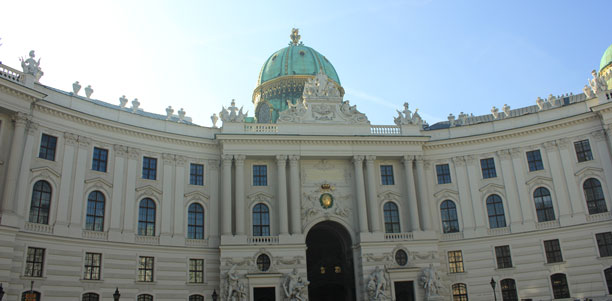Four exciting sights of Imperial Vienna

Viennese history is strongly connected to the history of the Austro-Hungarian Empire and the era of the reign of the Habsburgs. This period of time helped forge the image of Vienna, which is prevalent around the world until today – an inner city full of historic buildings, theatres, operas and museums, providing the perfect backdrop for Europe’s cultural and intellectual elite. And indeed, the remainders of that era still make for spectacular sights to visit all around the city. Visit these spots to tap into an exciting time of history and delve in the relicts of this period in time.
Hofburg Imperial Palace
The Hofburg is the former main imperial palace, situated in the city center and official residence and workplace of the Austrian President nowadays. It used to be the winter residence, housing the heads of the Habsburg dynasty for centuries. Today it also hosts three great museums which allow for a great historical perspective on the life at court: the Imperial Apartments, the Sisi Museum and the Silver Collection.
The Imperial Apartments are authentically furnished, providing an historically accurate insight into the life of the monarchs. The Sisi Museum is dedicated to Empress Elisabeth, affectionately nicknamed “Sisi”, who became a cult figure in her days and is remembered vividly until today. The Silver Collection is a comprehensive collection of utilitarian objects from the Imperial era, alluding to the splendor surrounding everyday life at court.
Schloss Belvedere
The Belvedere was built in the early 18th century as a summer residence for Prince Eugene of Savoy and consists of two baroque palaces and, today, serves as a home to several museums and art galleries. The beautiful gardens around the complex are a great place for a stroll and host one of Vienna’s most beautiful Christmas markets around Christmas time.
Schloss Schönbrunn
The Schönbrunn Palace used to be the summer residence for the Habsburg monarchs, with its vast gardens serving as a hunting and leisure area. Today, the palace is owned by the Republic of Austria and maintained as a major tourist attraction and museum, keeping the memory of the days of the monarchy alive. You’ll be able to see the authentically furnished chambers of the imperial family, as both the palace and the gardens have been kept largely in their original, historic state. Most of the 1441 rooms are open to the public, so you can take in the vastness of this architectural and historical monument.
Kaisergruft
The Kaisergruft – the Imperial Crypt – is a burial chamber situated close to the Hofburg Palace, which has served as the principal place of entombment for members of the House of Habsburg since 1633. It contains the bones of 145 members of Habsburg royalty, including 12 emperors and 18 empresses. The crypt has been renovated and reorganized in the 20th century to allow the preservation of the condition of the tombs in an environment of changing heat and humidity. Still, this place maintains the memory of a time long gone and the people connected to one of Europe’s great empires.

post a comment
You must be logged in to post a comment.